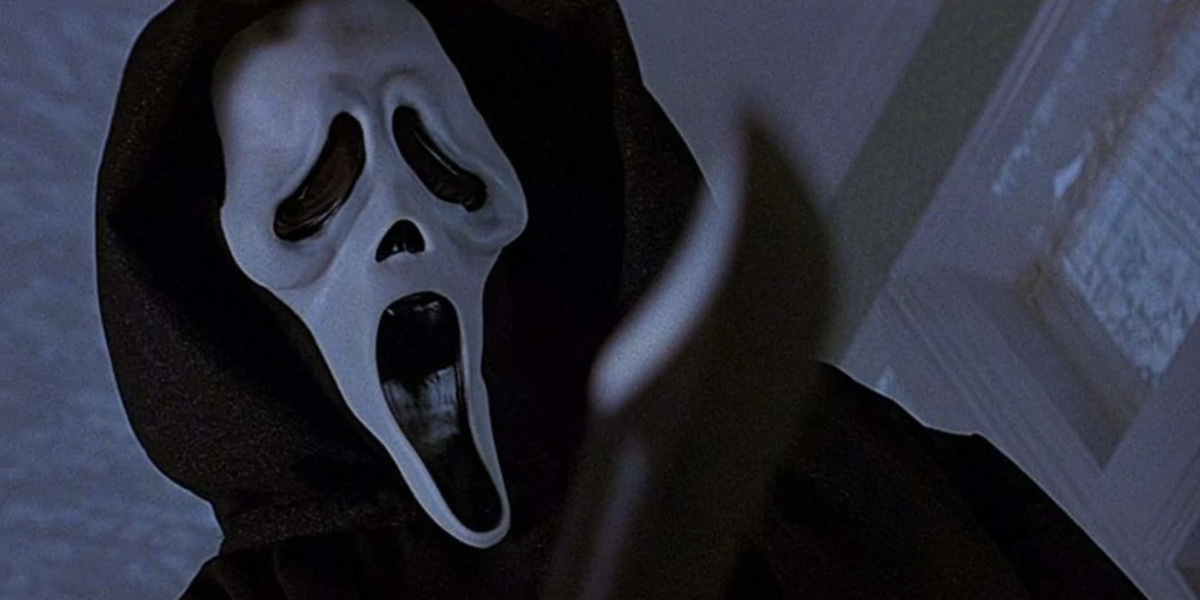Scream (5) (2022)
Hey, long time no write! Did you miss us? Sorry for the unannounced hiatus. We had a household emergency followed by a family emergency, which is still kind of ongoing, but we probably should have cranked something out by now. Or at least we should've said why we’re MIA. We’re only human though, right? What it comes down to is that we got tired and needed a break. Anyway, we’re back, and we have a new Judgment on the latest installment in one of our all-time favorite franchises!
--------------------
Sidney Prescott (Neve Campbell, left) and Sam Carpenter (Melissa Barrera, right) | Photos: Paramount
At first the idea of a fifth Scream movie (which we’ll call “Scream (5)”) seemed dubious. Think back on some other horror franchises. With a few notable exceptions, if a franchise gets to a fifth movie, it’s almost certainly not good. Maybe watchable, but not actually good. Let’s call it the Sometimes Mutable Law of Sequel Inferiority: On balance, sequels, even the solid ones, are rarely as great as, and even more rarely better than, the original; thus, further sequels are likely to result in further diminishing returns. (Just look at the endless Jason, Michael, and Freddy sequels of mostly questionable quality.) On top of that, without creator Wes Craven at the helm, what worthwhile experience, what new ideas, what interesting developments could possibly come from yet another Scream film?
That’s what we were asking ourselves, anyway. Then we found out Matt Bettinelli-Olpin and Tyler Gillett, creators of 2019’s Ready or Not, would be the filmmakers in this fifth installment and that they had recruited the core members of the original cast: Neve Campbell, Courteney Cox, David Arquette, and Roger L. Jackson (the voice of Ghostface), in what was being called a soft reboot of the franchise. (In the film, they call it a “requel.”) If anyone could pull off such a feat, this would be the team to do it.
The requel, it seems, has to bring both an end to the overarching story of previous films and a new beginning. It has to introduce new heroes connected to the old guard, new variations on old themes, new questions that echo old ideas, and new threats that grow from old terrors. It has to reach back to the original film, yet also break ties and build itself anew.
In our opinion, Scream (5) succeeds on all counts. Ghostface feels both familiar and reborn, the core cast find closure to their stories, and the filmmakers use Scream’s hallmark meta-comedy to offer new commentary on modern media and to ask new questions about America’s relationship with violence.
Let’s start with Ghostface, one of our favorite slasher villains. He feels human and superhuman at the same time. As Meg noted in her Dissection on the original Scream, Nick Cave and the Bad Seeds set the template for him in “Red Right Hand,” the franchise’s official theme song: “He’s a ghost, he’s a man, he’s a god, he’s a guru.” He seems to move unseen and without sound. Seems to be everywhere. To know everything. But in the end, Ghostface is a character played by vulnerable, emotional humans. And he can be killed.
(By the way, as we see it, Ghostface is a “he,” even when the killers who become him are women. Aside from his voice sounding male, his particular brands of misogyny and violence feel masculine. He also almost always plays a male character on the phone, and even when he plays women, he switches to the male Ghostface voice to reveal himself. Plus, the song says so.)
Ghostface gets his ass beat. A lot. Throughout the franchise, dude gets kicked in the face and hurled over balconies. Sidney (Neve Campbell) drops a TV on his head. He gets slammed by who knows how many doors. In the first film, Tatum (Rose McGowen) whips beer bottles at him and hits him in the balls. Ghostface’s ass-kickings reach Three Stoogean levels of slapstick rarely seen in serious horror movies. It’s funny, but at the same time, those beatings make him feel human because they show he’s not invincible. He’s not even a particularly good fighter. He’s just a wacko with a cheap costume and a knife.
The people who become Ghostface concoct motives that satirize pop culture ideas of why killers kill—peer pressure, violent media, online forums, and toxic fandom. But the killers themselves are more honestly motivated by misogyny, boredom, petty indignation, unrighteous revenge, and shallow lust for fame. All motivations driven by very human feelings of smallness, loss, anger, and jealousy. The franchise also features bizarre celebrity worship of serial killers, which at one time felt like part of the joke in Scream, but in these days of livestreamed copycat mass murders, it feels like a disturbingly spot-on critique of humanity.
Yet, despite his vulnerability, Ghostface can feel supernaturally unkillable. He often seems to be in two places at once, usually because he’s actually two people—except in one of the films; we won’t say which, but in that film, he seems to literally be in two places at once. On top of that, he’s impossibly stealthy and even seems to have actual powers over fate and luck that he draws from the “rules” of slasher movies.
All that is to say, we have specific and high expectations for Ghostface. Not all the Screams have equally met these expectations. The third installment, as noted, especially broke multiple parts of that mold. But this new Ghostface reads like the old, archetypal Ghostface: He reads as male, has ridiculous pop-culture-y motivations masking human misogyny and pettiness, and at the same time feels just as supernatural as he always should.
This Ghostface still gets beat to hell—kicked and punched and smashed by flying objects. But he’s also far more aggressive, brutal, and sadistic, and the camera less prone to shy away from his violence. On the phone, he strings his victims along more than he has previously, getting deeper in their heads. In this one sense, the new Scream (5) might actually be more successful than the original: This version of the masked killer is far more visceral and terrifying than he’s ever been. (Fight us.)
That’s not to say Scream (5) is better than the original Scream (1996). Or even as good as. That’s not a distinction we’d hand out lightly, especially since we regard OG Scream as being about as close to a perfect film as you can reasonably get. Seriously. We put it up there with The Wicker Man (1973) and Rosemary’s Baby (1968), and we rank those movies right alongside non-horror masterpieces like Citizen Kane (1941) and The Godfather (1972).
Good as it is, Scream (5) is not OG Scream. It can’t be, it shouldn’t try, and we’re not criticizing it for being a different movie. That would be stupid. Especially because it’s a good movie. That said, it does make some unfortunate missteps. One kill in particular is rather frustrating—someone who deserves a better death gets killed because they’re being foolish in a way that feels out of character.
There’s also a pretty strong case to be made that, in trying to establish a connection with the original Ghostface, the film accidentally redeems one of the original killers, a gaslighting misogynistic murderer who probably shouldn’t be redeemed. (Here’s a spoiler-laden summary from Screen Rant, if you’re interested.) Not to mention that the specific ways that the film brings in the original Ghostface (with a mix of CGI and makeup) are hammy and look kind of crappy onscreen.
But as sequels (or “requels”) go—let alone fifth installments—Scream (5) is impressive, maybe even better than any of the other sequels, all of which have contributed to a particularly strong franchise. Aside from its depiction of Ghostface being absolutely nightmarish, Scream (5) manages to do things the original did in ways that may not feel new, but are the most successful they’ve been since the OG film.
Take Scream’s meta-ness—that way the franchise has of referring to itself and other horror movies. These days, it’s pretty standard for a scary movie to refer to itself, its influences, and its genre, especially in horror comedy. It used to be that even the good horror movies were usually kind of bad, but in a campy, fun way. Like the audience was in on a joke that the characters in the film weren’t aware of.
But movies like Fright Night (1985), Friday the 13th Part VI (1986), Evil Dead 2 (1987), and later, Scream and Cabin in the Woods (2011) would introduce the self-referential meta-comedy that has, today, mostly replaced the campy fun of older slashers. Modern characters and films, on some level, are in on the joke with the audience. They know the horror tropes and genre trappings and sometimes special effects are kind of silly, and they indulge that silliness.
The OG Scream is the film that brought this meta-comedy into the mainstream, breathing new life into the slasher genre, which was, in the mid-‘90s, pretty tired, repetitive, boring, and awash with unremarkable sequels. Meta-comedy has been a central element of the Scream franchise ever since, and the films have used it to skewer America’s relationships with violence and misogyny, the media censorship debates of the ‘90s, our obsessions with image and narrative that come with social media, and in this most recent installment, the self-righteous indignation of modern fandom.
For some reason, media commentary is always the aspect of Scream movies that we (meaning us, Eric and Meg) expect to fail—assuming (wrongly) that everything’s already been said. And yet, in almost every installment, that meta quality stands out as a consistent strength of the franchise.
On this front, Scream (5) does exactly what this franchise has always excelled at. It takes the basic idea that these are movies about movies, media about media, and it goes on to say something new in and about the current media landscape. Right now, in this movie, that means commentary on “toxic fandom,” social media, and online radicalization. And again, it works incredibly well. The jokes are there, but that meta-ness also explains Ghostface’s behavior, his supernatural resilience, and even his very existence.
In other words, more than just for a laugh, the self-referential quality is part of the film’s plot, its characters, its rules, and the ways it finds to bend and break those rules. Ultimately, meta-ness may be the defining element of the Scream franchise. With Scream (5), Bettinelli-Olpin and Gillett have managed to build a requel/soft reboot around the original’s meta-skeleton that, in our estimation, actually lives up to Wes Craven’s legacy.







